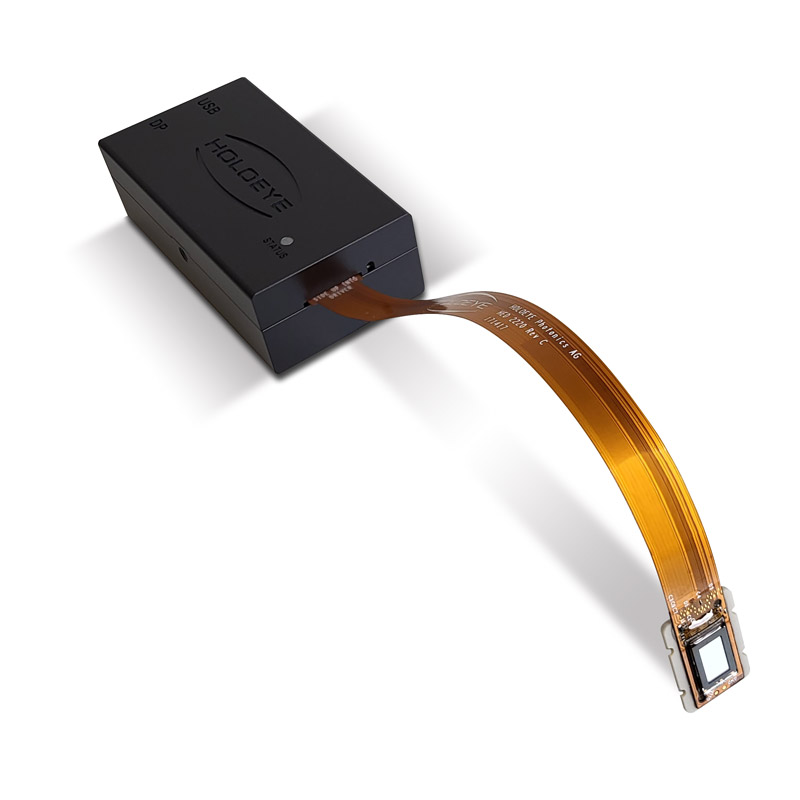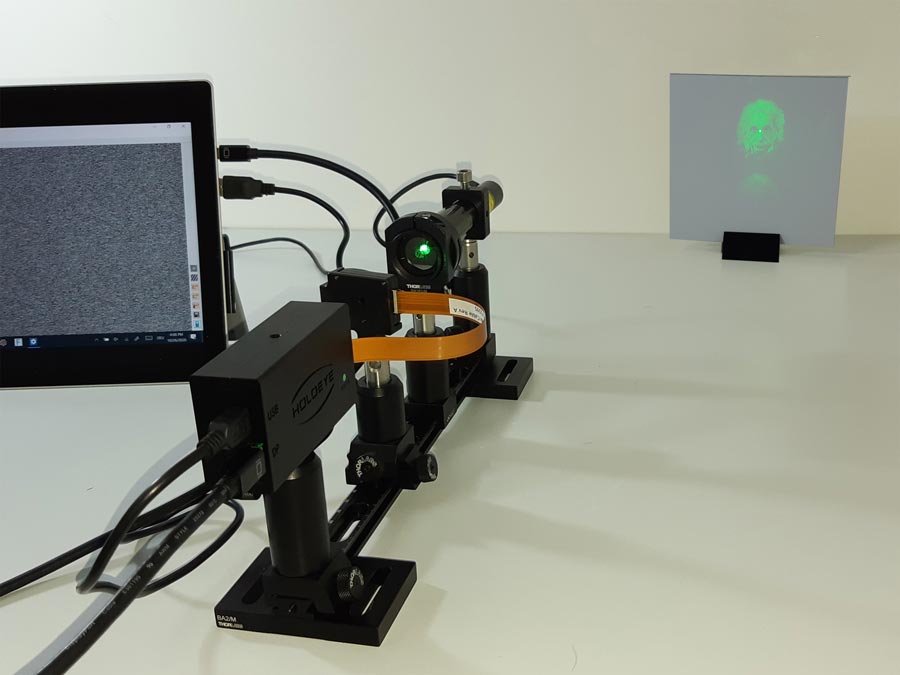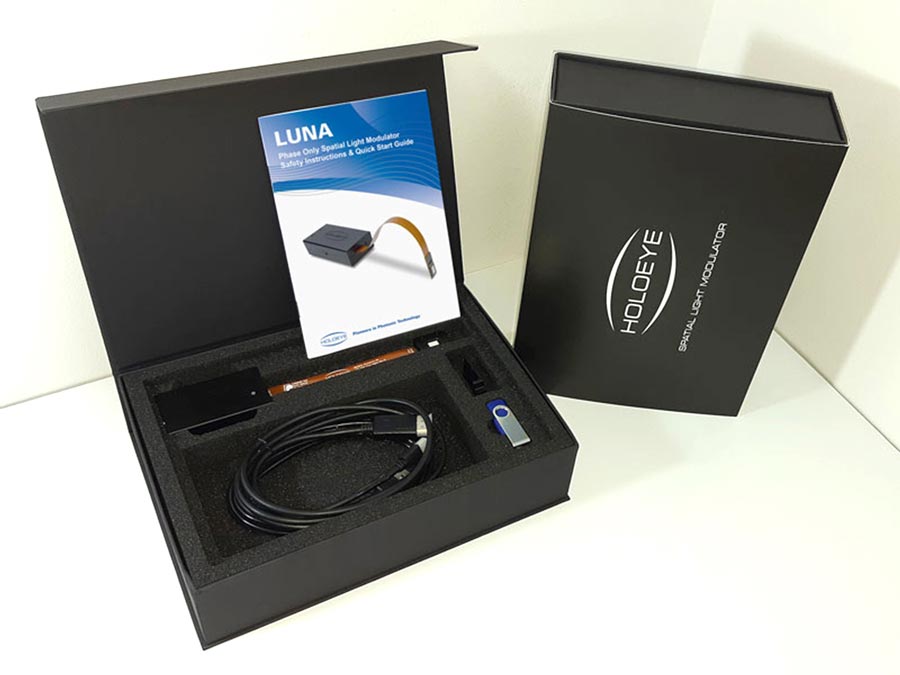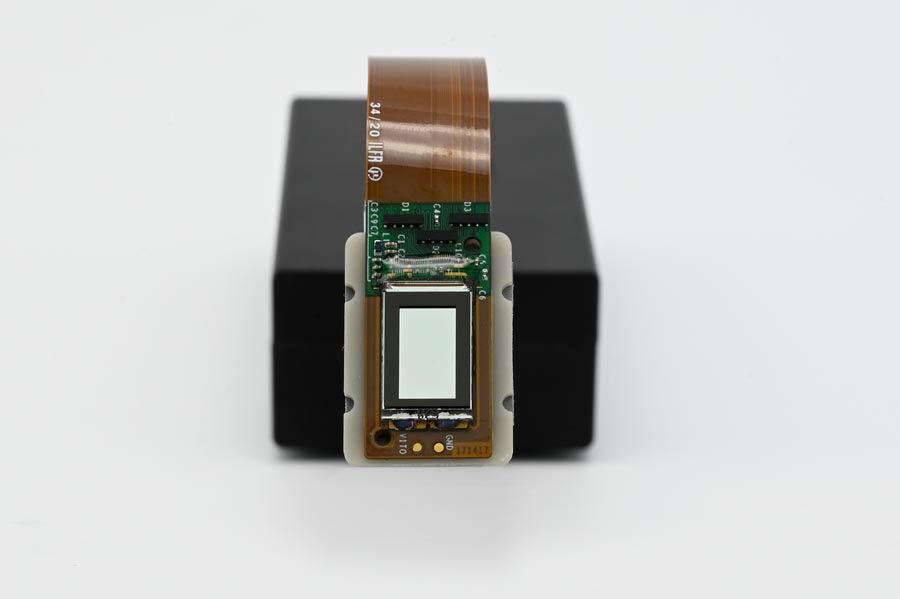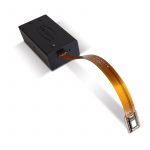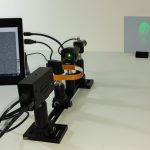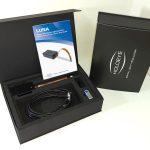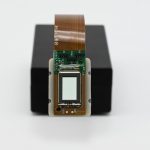LUNA Phase-Only SLM: Precision Light Modulation
The LUNA phase-only Spatial Light Modulator (SLM) features a compact design, integrating its driver unit with a standard DisplayPort interface directly into the Liquid Crystal on Silicon (LCOS) microdisplay. This full HD (1920 x 1080 pixel) display boasts a 4.5 µm pixel pitch, resulting in a 0.39-inch diagonal active area with a 16:9 aspect ratio. Its integrated driver saves space, making the system highly compact (driver box size: 84.4 x 47 x 28.8 mm) and simplifying integration. The SLM also supports 4-lane MIPI DSI video input, broadening its potential for industrial applications.
The LUNA-VIS-111 model is specifically designed for color field sequential (CFS) phase applications. It offers 32 or more linearly distributed phase values (ranging from 0π to 2.2π) for each red, green, and blue color channel. For optimal performance in CFS mode, especially for faster response times, the display requires a higher operating temperature of 55°C and specific voltage settings, which are stored in a configuration file. To effectively manage this temperature, using a HOLOEYE Thermal Management System (TMS) is strongly recommended.
Specialized Versions:
HOLOEYE offers different display versions optimized for various wavelength ranges:
- LUNA-VIS: Designed for the visible spectrum (420 – 650 nm).
- LUNA-NIR: Optimized for the near-infrared spectrum (680 – 1100 nm).
- LUNA-1550: Tailored for the telecommunication waveband (1400-1700 nm).

LUNA-VIS-111 for Color Field Sequential (CFS) Applications:
The LUNA-VIS-111 variant is specifically designed for color field sequential (CFS) phase applications. It supports 32 or more linearly distributed phase values (0π to 2.2π) for each color (Red, Green, Blue). For CFS operation, the light source is triggered for approximately 1.1 ms per color field. To achieve the faster response times required for CFS, the display operates at a higher temperature of 55°C with adjusted voltage settings stored in its configuration file. We strongly recommend using a HOLOEYE Thermal Management System (TMS) to effectively control the display temperature when operating in CFS mode.
LUNA Spatial Light Modulator Applications
- Digital/Computer Holography (CGH): The LUNA SLM’s ability to display complex phase patterns makes it a key component in generating and reconstructing computer-generated holograms. This allows for the creation of intricate light fields for various purposes, including optical trapping, microscopy, and advanced metrology. The high resolution and phase-only modulation capabilities are essential for accurate holographic reconstruction and manipulation.
- Augmented Reality (AR), Virtual Reality (VR), and Mixed Reality (MR): In AR/VR/MR systems, SLMs like the LUNA can be used to generate realistic virtual images or to overlay digital information onto the real world. Their ability to dynamically control light enables functionalities such as focus adjustment (varifocal displays), aberration correction, and the creation of true 3D volumetric images, enhancing user immersion and reducing visual fatigue.
- Holographic Displays: The LUNA SLM is a core technology for developing advanced holographic displays. By precisely modulating the phase of light, it can create true three-dimensional images that can be viewed from multiple perspectives without the need for special eyewear. This capability is critical for next-generation display technologies in areas such as signage, medical imaging, and entertainment.
HOLOEYE Spatial Light Modulator Catalog
Publications Featuring LUNA
-
Xiangrui Duan and Zichun Le, “Inter-layer edge supplementation in computer-generated multi-depth 3D holograms,” Opt. Express 33, 21453-21463 (2025)
- Fricke, S., Castillo, S., Eisemann, M. and Magnor, M. (2025), Real-Time Rendering Framework for Holography. Computer Graphics Forum e70058. https://doi.org/10.1111/cgf.70058
- Selim Duru, Buğra Er, Görkem Bavtar et al., “Design of an LED and Laser Diode Based Optical Vehicle Alerting System“, International Journal of Automotive Science And Technology 9(1), pg. 106, (2025); doi:10.30939/ijastech..1603306
- Natsu Kikuchi, Seok Kang, and Yuji Sakamoto, “Head-mounted projector with a wide visual-field and three degrees of freedom in electro-holography,” Appl. Opt. 64, B58-B64 (2025)
- D. O. Galkin, I. A. Lyashko, D. M. Demchenko, D. A. Kuzmenko, and V. A. Brazhnikov “Modeling of the formation of an image with improved resolution of an electron-optical image converter on a microchannel plate“, Proc. IOP Conf. Series: Journal of Physics: Conference Series 2407, 012016 (2022); https://doi.org/10.1088/1742-6596/2407/1/012016
LUNA Software
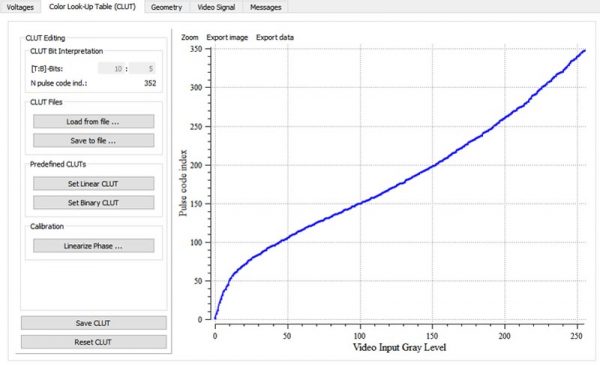
The LUNA phase-only SLM is designed for straightforward integration and operation. You can address the device like an external monitor using your graphics card’s standard DisplayPort interface, eliminating the need for additional software or dedicated hardware for basic functionality.
For advanced control and calibration, the LUNA SLM includes the Configuration Manager software. This tool lets you adjust geometrical settings, brightness, contrast, and fine-tune the electro-optical response by applying custom gamma curves or different digital drive schemes. These advanced calibrations utilize a USB connection to a virtual COM port on your computer.
The SLM also comes with several powerful software tools to enhance its capabilities:
- HOLOEYE SLM Pattern Generator software: This allows for the computation of computer-generated holograms (CGH) from your own images. It also generates SLM signals for fundamental optical functions like lenses, gratings, axicons, and vortex functions, and enables the superposition of CGHs with these basic optical functions to combine functionalities.
- SLM Slideshow Player software: A dedicated application for displaying sequences of images or patterns.
- SLM Display SDK: Available for download, this Software Development Kit provides APIs (Application Programming Interfaces) for various programming languages, enabling you to display images and data/phase arrays directly on the HOLOEYE Spatial Light Modulator. Supported languages include:
- National Instruments LabVIEW™ 8.6 and later
- MathWorks MATLAB® R2009b and later
- Octave 5.2
- Python™ 2.7 and 3.x
- C or C++ compiler (e.g., Microsoft Visual C++ Compiler)
LUNA Spatial Light Modulator Kit Contents:
- Phase only display incl. flex cable
- Driver unit
- Display mount
- Display mounting adaptor
- Screw adaptor M4 to 1/2″
- USB cable
- Displayport / Mini DisplayPort cable
- CFS-light source sync cable
- Safety instructions & quick start guide (test polarizer inside)
- USB flash drive with software package and documentation




